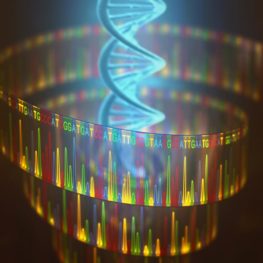
Photo: Sequencing
A 25-year diagnostic odyssey across three continents finally came to an end for the parents of a pair of sisters who as children slowly became paralyzed from the waist down.
The diagnosis came from researchers at the University of Southern California (USC) and Translational Genomics Research Institute (TGen), an affiliate of City of Hope who used mRNA sequencing to discover an extremely rare genetic variant that was the cause of their disorder. Their findings were reported in the scientific journal Human Mutation.
Thanks to a chance viewing on French TV of a story about another physically disabled child who regained her mobility after being diagnosed at TGen’s Center for Rare Childhood Disorders, the parents of the two sisters contacted TGen, hoping to end their decades-long diagnostic odyssey.
“The girls’ parents were one of the many who emailed me after seeing the TGen interview on French TV,” said Matt Huentelman, professor of TGen’s Neurogenomics Division, Scientific Director of the Center, and one of the paper’s authors. “I can still remember the pain, desperation and hope expressed in those emails.”
Using multiple analyses of the sisters’ and family members’ genomic sequencing, TGen and USC investigators found that an extremely rare genetic variant in the gene AP4S1 was the likely culprit that left the girls, by age 5, paralyzed from the waist down.
Twenty years later, following a physical exam at ages 24 and 25, their physician noted that the sisters were “pleasant and happy,” but remained shy, unable to talk, and still in need of their motorized wheelchairs. The sisters have required multiple foot surgeries associated with their condition, have no bladder or bowel control, and require daily assistance with bathing, feeding and dressing.
“This family literally went all over the world in search for a diagnosis,” said Newell Belnap, clinical research coordinator at the TGen Center, and one of the study’s authors.
Originally from the Democratic Republic of the Congo, in east Africa, the family eventually traveled to Paris, France, Geneva, Switzerland, and elsewhere in Europe before arriving in the United States in 1999, all the time in search of a doctor who could provide a diagnosis.
In 2014, the parents saw a story featured on France 2, the French national television channel, about a young girl who after being diagnosed and treated at the Tgen Center, was able to discard her wheelchair, stand and walk, and even dance.
Eventually, after finding their way to the Tgen Center, the sisters, other siblings, and their parents had their DNA sequenced. Initially, TGen and USC researchers could not find a cause for their disabilities.
“Given the lack of evidence for a causative variant, we performed RNA sequencing and compared the resulting gene expression profiles to a broader group of more than 150 other pediatric patients enrolled under our research protocol,” said Vinodh Narayanan, the Center’s Medical Director and one of the study’s authors.
Using these precision medicine techniques, the team was able to pinpoint the extremely rare variant, one that had been skipped over by researchers in the past, in the AP4S1 gene.
“This in-depth case study demonstrates the utility of whole-blood mRNAseq—even when genes are expressed at very low levels—in identifying a variant not previously considered likely pathogenic,” said David Craig, a former TGen researcher who now is co-director of the USC Institute of Translational Genomics at the USC Keck School of Medicine. Craig is the senior author of this study.
“Given that DNA and RNA can be obtained at the same time—and integrative analytical frameworks, such as ours, can gather additional evidence—these approaches have the promise to improve clinical diagnosis, especially in some diseases where most patients remain undiagnosed even after genome or exome sequencing,” Szelinger said.
Author: Rare Daily Staff

Stay Connected
Sign up for updates straight to your inbox.
